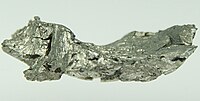
Photo from wikipedia
The unconventional ferromagnetism of Ag as been studied in highly pure nanomaterials. Gas-phase synthesis of nanoparticles and thin films allow for the independent study of size and ligand-free surface effects.… Click to show full abstract
The unconventional ferromagnetism of Ag as been studied in highly pure nanomaterials. Gas-phase synthesis of nanoparticles and thin films allow for the independent study of size and ligand-free surface effects. No size correlation to magnetism in Ag nanoparticles ranging from 3.3 ± 0.9 to 7.8 ± 1.3 nm was determined by superconducting quantum interference device (SQUID) magnetometry. Additionally, magnetic quartz crystal microbalance (MQCM) under vacuum conditions of 3.3 ± 0.9 nm Ag NPs shows magnetic behaviour only after the onset of oxidation. SQUID magnetometry shows a higher magnetization for samples exposed to O2 compared to inert atmospheres. This indicates non-stoichiometric oxidation at the surface as the reason for the observed magnetism as supported by an ∼8 : 1 Ag : O ratio from MQCM measurements. Additionally, heat-treated Ag thin films present a lower saturation magnetization compared to those kept in O2 without heating. This latter observation could be the result of driving the oxidation to stoichiometric surface oxides AgO and Ag2O which are known to be diamagnetic.
Journal Title: Journal of Materials Chemistry C
Year Published: 2017
Link to full text (if available)
Share on Social Media: Sign Up to like & get
recommendations!